Self Driving Vehicles Newsletter February
Here is the self-driving vehicles newsletter that summarizes monthly news from OEMs, Tier-1 suppliers and start-ups who develops self-driving vehicles for safer and more efficient transportation future. Enjoy!
Ford to Invest $1 bIllIon In ARGO AI
Argo AI is an artificial intelligence company, based in Pittsburgh and established at 2016. Founded by former Google and Uber roboticians.
$1 billion investment will be made during next 5 years.
Ford will be working on autonomous hardware platform and system integration while Argo AI will focus on to solve machine learning and robotics difficulties to make commercially available SAE Lvl 4 self-driving car by 2021.
Main aims behind this investment for Ford are to boost current developments via speed of a startup and to build technology which can be licenced for future players.

| Ford | Argo AI investment announcement could be found on the link |
Source:media.ford.com
Ford – RWTH aachen coLlaboratIon for vIrtual assIstants
By 2022, it is expected to have voice recognition capability available %90 of all new cars.
Ford with RWTH Aachen studing on to enable facial and voice based virtual assistants available within its new cars. Noise effects are trying to be reduced for better voice understanding on this collaboration.
Currently, Apple CarPlay and Android Auto makes avaible voice recognition within cars by Siri and Google Now respectively.
By Q3 of 2017, Sync will enable to connect Amazon Alexa as well.

Source: media.ford.com
EthIcal dIlemmas of self-drIvIng cars
Ethical decision making is as much important as building succesful SAE Lvl 4 AV as well due its industry effective impacts, and it is a main object for industry regulation makers.
Even self-driving cars may reduce traffic accidents significantly, there could be a situation that have to choose between sacrificing itself or pedestrians.
If AVs be an utilitarian (sacrifice passengers, good for others) it will be less wiling to buy an AV. But a Science Magazine article shows this opinion not correct according to their latest survey.
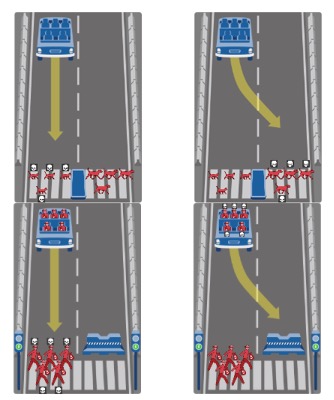
Here is some other resources for this subject;
The Social Dilemma Of Driverless Cars | TEDxCambridge Research of MIT on Human Perspectives on Machine Ethics
Soruce: weforum.org
Toyota Research Institute showed its 2nd generatIon SDC
New development vehicle focuses on machine vision and machine learning heavily,
Lidar, radar and camera sensor are used rather than high definition maps,
Platform designed to be flexible, new hardware and software updates possible,
Toyota Research Institude currently developing «Chauffeur» a SAE Lvl 4 autonomous driving and «Guardian» a driver assist system.
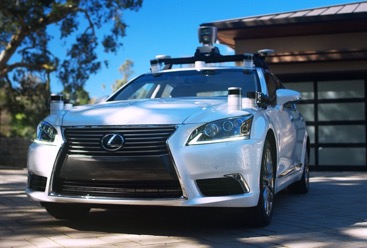
Source: pressroom.toyota.com
Mercedes-Benz starts ‘small serIes productIon’ of all-electrIc Urban e-Truck
The project has been released on July 2016 first and now Mercedes-Benz starting to deliver small-series production all-electric urban heavy trucks to its customers,
The vehicle have 212 kWh battery with 200km mileage per charge and 26 tonnes capacity for in-city deliveries,
Test period will be 12 months and final version will be released at 2020,
There are also Nikola Motors and Tesla Semi for all-electric trucks need to be followed closely.
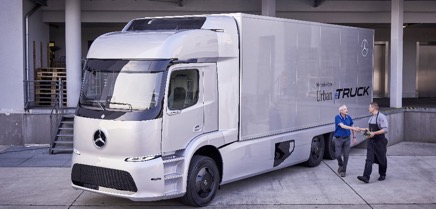
Source: electrek.co
BMW, HERE and MobIleye Team Up To HD Maps For Self-DrIvIng Cars
According to HERE’s recent announcement, BMW vehicles will be equipped with Mobileye and HERE systems starting in 2018.
Mobileye will use its REM (Road Experience Management) system to recognize road side features that could affect road configuration like road changes or stationary objects etc.
Later; REM will compare current situation with in-vehicle database condition and send differences to HERE.
HERE will combine all updates comes from vehicles in the field and make combination with its map and spread back latest condition to all connected vehicles.
On this technology; stationary objects could be used for triangulation of vehicle localization.
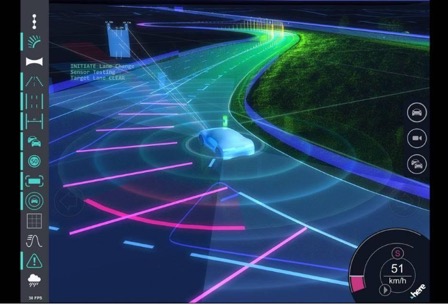
Source: forbes.com
A debate: Role of deep learnIng on SDC decIsIon makIng
There are currently 2 methods to accomplish decision making of a self driving car. Both have advantages and disadvantages, industry players are spliting into 2 categories in this subject;
Deep learning techniques:
Woks exceptionally well at most cases (%99 accuracy is possible), There is no rule that human explicitly programmed, By feeding large amount of driving scenarios model learns and predicts at test conditions, Drawback: interpretability issue «black-box», Drive.ai, AImotive, Five.AI.
Rule based visionary techniques:
Logic based, mathematical approches, Errors could be understandable in human perception, causing of an issue can be found, Drawback; difficult to define every condition, challenging to apply, Ford, NuTonomy.
Source: forbes.com
Embark: new self-drIvIng truck startup
Embark is an another start-up on long haul self driving truck area as Otto.
Startup has been grounded-up from Varden Labs that known as self-driving shuttles for university campuses testing.
Company’s aim is to deliver autonomy for highway and driver take over when exiting like Otto.
Their tests are continue on Nevada deserts.
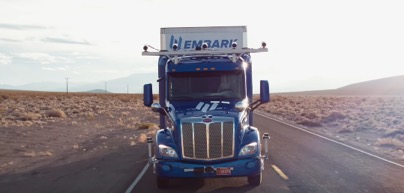
Here is the link for their recently published trailer video.
Source: recode.net
Starsky robotIcs: AN Another new self-drIvIng truck start-up
Starsky Robotics is another new California based start-up company.
They have a difference from others, their system let remote driver know when the truck is about to exit and remote driver drives until final destination.

Here is a link to thier first freight.
Source: roboticstrends.com
Successful self drIvIng demo vIdeo from drIve.ai
drive.ai is released a 3:45 seconds video recently where a demo vehicle runs at night on a rainy day and self-driving car succesed to drive with no human intervention. Challenging environmental conditions were;
Rainy night Narrow street Upcoming traffic İntersection with traffic lights Reflection from wet ground
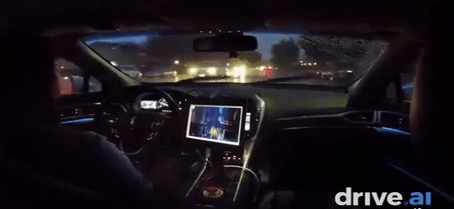
Here is a link for this drive.
Source: roboticstrends.com
Successful self drIvIng demo vIdeo from GM CruIse AutomatIon
Cruise automation is released a 3:09 seconds video recently where a demo vehicle runs at San Francisco on a clear day and self-driving car succesed to drive with no human intervention. Challenging environmental conditions were;
Down and uphills A cyclelist crossing by vehicle Road construction Pedestrians No lane marking on some road or not clear
It stops on every pedestrion crossings, remains safe drives on intersections and overtakes a stopped truck on narrow both-way street

Here is a link for this drive.
Source: roboticstrends.com
Tesla autopIlot 2.0 faIls on wIndy road
Autopilot 2.0 has been released recently with new feature called low-speed autosteering where intended to use for non-highways,
Despite good weather and lane marking conditions, it fails at night on windy day. The vehicle constantly veers off.

Source: roboticstrends.com
ComparIsIon of companIes by theIr SDC dIsengagement report
According to disengagement reports shared to Department of Motor Vehicles in California by companies perform field tests in California, Waymo is far ahead from other industry players on mileage driven autonomously per number of disengagement,
In below overall comparision table and Ford disengagements can be seen;

Source: roboticstrends.com
NIO broke self drIvIng electrIc vehIcle lap record at COTA
NIO is a brand of Chinese electrical supercar start-up NextEV,
The company runs a vehicle at Formula-E, developes an autonomous vision vehicle «eve» (will be available in 2020) and a supercar «EP9»,
EP9 has 4 inboard motors and 4 individual gearboxes (1 MW in total, 1360PS equivalently), accelerates from 0-124 mph in 7.1 seconds, has a top speed of 194 MPH. Battery system can be charged in 45 minutes and has a range of 265 miles.

Source: jalopnik.com
WAYMO sues UBER over their custom built lidars
Lidars are major sensor of Google WAYMO’s self-driving technology today and they are building camera and radar systems to give redundancy to the system,
Begining from 2009, Google developed custom in-house lidars for themselfs to have more reliable and cost efficient sensors compared to the off-the-shelf products,
According to recent post and sue of Google; they have seen a board of UBER lidar which has high similarity between Google lidar developments,
One of the other comment of the post also states about conflict on these two company; «six weeks before his resignation this former employee, Anthony Levandowski, downloaded over 14,000 highly confidential and proprietary design files for Waymo’s various hardware systems, including designs of Waymo’s LiDAR and circuit board.»
Anthony Lewandowski is DARPHA Grand Challenge competitor, former Google self-driving project technical lead and founder of OTTO that acquired by UBER.
Jalopnik’s comment on this lawsuit: “The self-driving tech. wars have begun, everyone.”
Source: medium.com/waymo
BuIldIng a Road Map for the Self-DrIvIng Car
Digital maps for autonomous cars are for to know the locations of cars, curbs and other objects within about 10 milimeters. Main OEMs use digital maps along with camera and other vision sensors to give reducdancy to a system,
Digital map creation made by lidars by creating images of the road and the surroundings. Later; engineers go over the images and tag the objects that are found, like stop signs, buildings, stoplights and do-not-enter signs,
Waymo has created maps for roads around in Mountain View, Austin and Kirkland. And also HERE acquired by German automakers is creating digital maps around Europe and US as well in collaboration with Mobileye. Civil Maps working in same domain as well and they are in collaboration with Ford,
Mostly; reliable systems have server connections and digital map updates made according to vision sensor detections like constructions, pulled of vehicle etc. Later; recent digital map distributes to all vehicle on the roads. This called as «fleet-learning».

Source: nytimes.com
GM plans to test thousands of self-drIvIng Bolts In 2018
Begining in 2018, General Motors plans to test its self-driving electrical Chevrolet Bolt fleet in collaboration with Lyft,
It is known as biggest autonomous test fleet before 2020 and GM’s intention for autonomous business is to deliver ride-sharing for its customers,
GM invested to Lyft in 2016 and Lyft is known as second biggest ride-sharing company after UBER,
GM currently runs 40 Bolt AVs in San Francisco, Arizona and Detroit,
Cruise Automation acquired by GM previously and they launched autonomous business Maven.

Source: reuters.com
